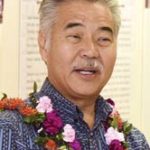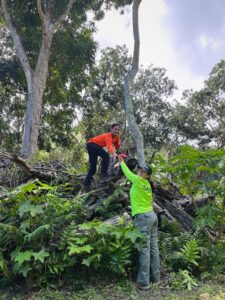Gov. Ige defends state DOT on bypass
One critic faults DOT communication but Ige says officials are ‘more engaged’
With the latest phase of the contentious Lahaina bypass to be blessed in a week, Gov. David Ige defended the Department of Transportation’s plans for the highway and its interaction with the Lahaina community.
“I can definitely tell you that they are more engaged with the community than departments in the past have been,” Ige said Thursday in an interview with The Maui News. “I know and stress with the directors all the time that we need to continue to reach out to the community.
“Because we don’t have the funds to do the project at one time, these are implemented in phases. They are looking at what would make the most sense based on the phase they are putting online.”
A blessing for the southern phase of the Lahaina bypass will be held at 2 p.m. April 15, Ige’s office confirmed Thursday. The 2.6-mile stretch likely will open later in the week.
The $38.7 million phase runs from “cut mountain” near Olowalu and connects to the bypass at Hokiokio Place. The entire highway will go from “cut mountain” to Keawe Street and bypass the coastal Honoapiilani Highway.
The Transportation Department has extolled the benefits of the phase as an alternative to Honoapiilani Highway, which is threatened by coastal erosion with water washing over sections of the road during high tides.
Residents, lawmakers and businesses, however, are up in arms, especially about changes at the Keawe Street terminus, which connects with Honoapiilani Highway in town. The Transportation Department projects a 70 percent increase in traffic on the bypass with the opening of the new phase and has made changes at the northern Keawe Street terminus to accommodate the increase.
One of the two Kaanapali-bound lanes on Honoapiilani Highway at the intersection has been turned into a right-turn lane, and vehicles coming off the bypass will be allowed free-flow onto Honoapiilani Highway.
Since learning of the specifics of the changes at the Keawe Street terminus late last year, community members and lawmakers have raised safety and congestion issues about the already often-bottlenecked intersection. They have questioned why at the “cut mountain” junction Lahaina-bound traffic cannot access Honoapiilani Highway.
West Maui Taxpayers Association Vice President Joe Pluta, a vocal opponent of the changes, said Wednesday that communication between the department and the community has been “terrible.” Meetings have been held with department officials, but community concerns and suggestions have not been addressed or adopted.
West Maui state Rep. Angus McKelvey, who has been targeted for criticism by the department, said the community is resigned to the opening of the new phase of the bypass and the changes at Keawe Street.
“There is that sense of resignation . . . and anger,” he said Thursday. “Them screwing it up is why people are not happy right now.”
Ige countered that there has been community engagement by the department and himself and that the plans are based on department data and models.
“It is something the department has worked a long time on, and they have traffic data that they are basing their decision on,” Ige said. “They have models to be able to predict how the traffic would flow and what would be in the best interest of moving traffic through.
“So certainly at some point in time you gotta make a decision, use their best judgment about what would work best for the community. They are committed to finishing the project.”
Once the bypass extension goes online, the department will monitor traffic and flow, he said.
“They are prepared to make changes as necessary to get the project to work right on behalf of the community,” Ige said. “They are committed to making adjustments and changes if they are wrong.”
West and South Maui state Sen. Roz Baker, who has held legislative office for more than 25 years, said department engineers make the decisions these days, telling communities “this is how we are going to do it.”
“I think that is how you get off on the wrong foot with the community,” she said.
This wasn’t always the case. During an earlier phase of the bypass, a resident told Baker the traffic design would lead to vehicle lights shining into her home.
Passing the information on to then department engineer Charlene Shibuya, Baker said Shibuya went to speak to the resident, determined that the concern was accurate and tweaked the plans to fix the problem.
“We don’t have folks who do that anymore,” Baker said.
Ige said that community suggestions, including some he passed on to the department after meeting with residents, have been analyzed by department professionals. Some, like restriping and changing turns, could be done quickly and without major expense; others, like a roundabout, would be costly and could require an environmental impact statement that would push work back as long as five years.
One community suggestion, allowing Lahaina-bound traffic to flow onto Honoapiilani Highway at the “cut mountain” junction to reduce the load on the bypass, is being re-evaluated by the department, said Ige. Part of the challenge, though, is how to make the physical changes to the highway.
The congestion at Keawe Street might be more palatable if the next phase of the bypass — from Keawe Street to Kaanapali — were in the works. Ige said there currently is not enough money in the highway fund for a large expenditure on a project like that.
“We do have to live within the funds that we have,” he said, noting that the highway fund contains $140 million annually including federal funds. “And unless we can get new revenues, we are going to have to make those choices.”
Most of those funds are going into repair and maintenance projects statewide and smaller lower-cost projects like contra-flow or lane additions, he said.
“Traffic is a high priority issue across the state, and we have been working and have implemented a number of low-cost improvements that we could do,” he said.
The governor’s efforts to raise more money for the highways fund, including raising vehicle registration fees and vehicle weight and gas taxes, have failed in the Legislature. “That’s why we take the funds that we got and try to stretch them into as many projects as we can,” Ige said.
He is open to new revenue streams, such as increasing the car rental tax, toll roads and the counties pitching in, possibly through increasing the general excise tax a half percentage point to fund highway projects.
Many in the Lahaina community have said that given the choice they would have rather had the department complete the Keawe Street to Kaanapali phase before the current one. That phase would create the bypass of Lahaina town, the whole point of the highway.
Residents have complained, as Baker noted, that Oahu department officials are making decisions about their communities. Ige deflected that complaint, saying that the decision on which phase to build first was “determined by legislators there.”
“It’s not something, I am pretty certain, that the Department of Transportation decided to do from Oahu,” he said.
Not so, said McKelvey and Baker.
“If that is what he is assuming, he is wrong,” Baker said.
She recalled that federal money was freed up for coastal erosion projects, and Honoapiilani Highway in the Olowalu area was facing those problems. Residents believed that the money would be used to shore up Honoapiilani Highway, but the department chose to use the money to build the current phase of the bypass.
“There wasn’t a lot of conversation,” Baker said, noting that the situation was compounded by multiple Maui County district engineer changes at the time.
The irony is that the worst erosion occurring on the highway was farther south, outside the bypass extension project, she said.
On other end of the bypass, Baker said the Kaanapali leg has all of its entitlements and only needs the money. The state Senate budget has money for the Kaanapali phase — $8 million in revenue bonds and $40 million in federal funds.
She and McKelvey both pointed out that the department recently received a $50 million windfall in federal highway money from unspent California highway funds.
Baker said she told department officials: “I have a project just under that.”
There is money for the northern phase of the bypass in the House budget too, said McKelvey. It also includes an increase in the rental car tax to help fund the highway, which has morphed back generally into the original bill he introduced.
The measure had been changed to throw all of the additional revenue into the general highway fund.
Baker said that she has received a commitment from department officials that if the measure is included in the state budget passed by the Legislature, the department would build the Kaanapali phase. She also complained about having to take the initiative without support from the Governor’s Office on this measure.
For his part, Ige said it would have been easy for him “to have gone to these town meetings and when they ask me to step in I make the promise, ‘Oh, you know you are right. I am going to step in and stop this project.’
“I’m not the typical politician that’s going to do that and be dishonest with the people in Lahaina. It’s gotta make sense.”
* Managing Editor Lee Imada can be reached at leeimada@mauinews.com.
- GOV. DAVID IGE Defends DOT’s bypass planning
- Motorists travel on Keawe Street above the Lahaina Gateway shopping center as the sun sets behind Lanai in December. Keawe Street is the northern terminus of the Lahaina bypass and has become a focal point of community concern about traffic with the opening of the new southern segment of the bypass highway. Gov. David Ige is defending the state Department of Transportation’s management of the project and its communication with residents. The Maui News / MATTHEW THAYER photo





